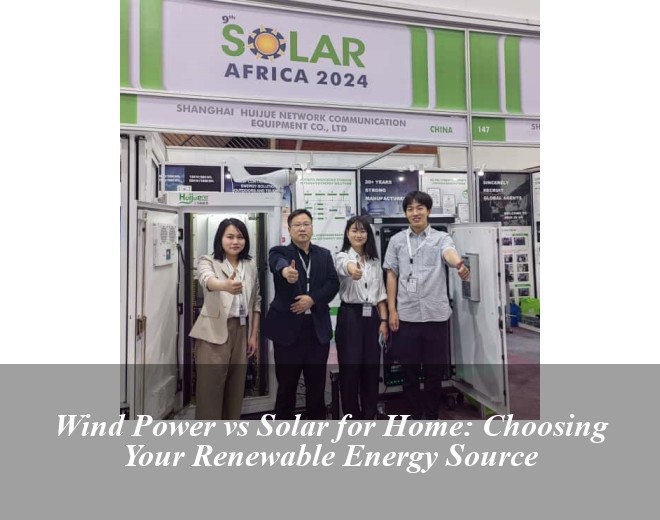Home Wind Power vs Solar: Choosing Your Renewable Energy Source

Table of Contents
The Basics: How Home Wind Power and Solar Systems Work
Let's cut through the jargon. Residential wind turbines convert kinetic energy from wind into electricity through rotating blades, while solar panels use photovoltaic cells to transform sunlight. Simple enough, right? Well, here's where it gets interesting. Wind systems typically generate power 24/7 if conditions allow, whereas solar only works during daylight hours. But wait – doesn't that make wind the obvious winner? Not so fast.
Consider this: The average U.S. household needs 10-12 solar panels (about 5kW system) versus just 1-2 small wind turbines (5-15kW). But turbine effectiveness plummets if your backyard wind speed drops below 9 mph. Meanwhile, solar keeps chugging along even on cloudy days, just at reduced efficiency.
Location, Location, Location
Your ZIP code decides this battle more than technical specs. Take Texas – the U.S. leader in both technologies. The Panhandle's constant 13 mph winds make wind energy a no-brainer. But in central Austin? You'd better stick with solar. Coastal regions like Cornwall, England, often benefit from hybrid systems due to consistent sea breezes and moderate sunlight.
Here's a pro tip most installers won't mention: Check your local "capacity factor." This measures actual energy output versus maximum potential. Solar averages 15-22% in temperate zones, while residential wind systems hit 25-35% in Class 3 wind areas. But if you're below Class 2 winds (less than 11.5 mph average), your turbine becomes an expensive lawn ornament.
The Real Cost Breakdown
Let's talk numbers. A 5kW solar array costs $11,000-$14,000 after federal tax credits. A comparable 10kW wind system runs $35,000-$50,000 installed. Seems lopsided? Hold on – wind systems typically last 20-25 years versus solar's 25-30. And here's the kicker: Properly sited wind turbines can generate 2-3x more daily power than solar in optimal conditions.
- Solar payback period: 6-8 years
- Wind payback period: 10-15 years
- Hybrid system premium: 18-22% additional cost
But wait – these numbers assume perfect conditions. In reality, 62% of hybrid system owners report higher satisfaction than single-source adopters, according to 2023 DOE data. Maybe the best solution isn't choosing between wind and solar, but using both strategically.
When 1+1=3: Hybrid Energy Systems
Your solar panels juice up batteries during the day while your turbine takes over at night. During a 2023 winter storm in Minnesota, hybrid homes maintained power 73% longer than solar-only setups. The secret sauce? Diversity in generation sources.
Michigan's "Solar + Wind" rebate program (launched April 2024) offers 15% discounts for combined installations. Early adopters report 92% energy independence – enough to power homes and charge EVs simultaneously. But is this feasible everywhere? Probably not in Manhattan high-rises, but definitely in rural Ohio.
The Maintenance Reality Check
Solar panel cleaning costs: $150-$300 annually. Wind turbine maintenance? $400-$600. But here's the rub – a single lightning strike can fry your turbine's controller (ask me how I know). Solar arrays face fewer moving part failures but suffer gradual efficiency loss. Choose your headache.
Quick Questions Answered
Q: Can I completely go off-grid with either system?
A: Possible with sufficient battery storage, but most homes keep grid connection as backup.
Q: Which has better resale value?
A: Solar increases home value by 3-4% nationally. Wind systems only add value in rural markets.
Q: Do HOA restrictions apply?
A: Solar enjoys legal protection in 38 states. Wind turbines? Still face NIMBY opposition in 72% of suburban communities.
Q: What about extreme weather durability?
A: Modern solar panels withstand golf-ball hail. Wind turbines auto-brake at 55 mph winds – crucial in hurricane zones.
Related Contents

Wind Power vs Solar for Home: Choosing Your Renewable Energy Source
Let's cut to the chase - choosing between wind power and solar energy for your home isn't about which technology's cooler. It's about where your roof (or backyard) sits on the map. Take Texas, for instance. The state's been installing residential wind turbines like there's no tomorrow, but that's not just cowboy enthusiasm - their average wind speed of 14 mph makes it work.

Solar Energy, Wind Power, and Water Power Are Reshaping Our Energy Future
Let's face it—the energy transition isn't some distant future scenario anymore. Solar energy installations grew 35% year-over-year globally in 2023, while wind power accounted for 8% of Europe's electricity mix last winter. And get this: hydropower still provides over 60% of Brazil's electricity. But wait, aren't we supposed to be phasing out old tech? Well, that's where things get interesting.

Cheap Home Solar Power Kits: Your Gateway to Energy Independence
Let's face it – electricity bills are kind of out of control. In Texas, where I helped install a cheap home solar power kit last month, families saw a 40% price hike during the summer heatwave. But here's the kicker: solar panel costs have actually dropped 80% since 2010. Makes you wonder – why aren't more people switching?

AC Unit Solar Power: Revolutionizing Home Cooling with Renewable Energy
Did you know air conditioning accounts for 12% of U.S. household energy use? That's like leaving 15 light bulbs on 24/7! As temperatures keep breaking records - remember last month's 122°F (50°C) heatwave in India? - our reliance on AC units grows. But here's the kicker: conventional systems are sort of trapped in a vicious cycle. The more we cool our homes, the more we heat the planet through power plant emissions.

Solar System for Home Power: Your Gateway to Energy Independence
Ever opened your electricity bill and felt that sinking feeling? You're not alone. Millions of homeowners worldwide are discovering that home solar power systems offer more than just environmental benefits - they're becoming financial lifesavers. In the U.S. alone, residential solar installations jumped 34% last quarter according to recent data.




 Inquiry
Inquiry Online Chat
Online Chat